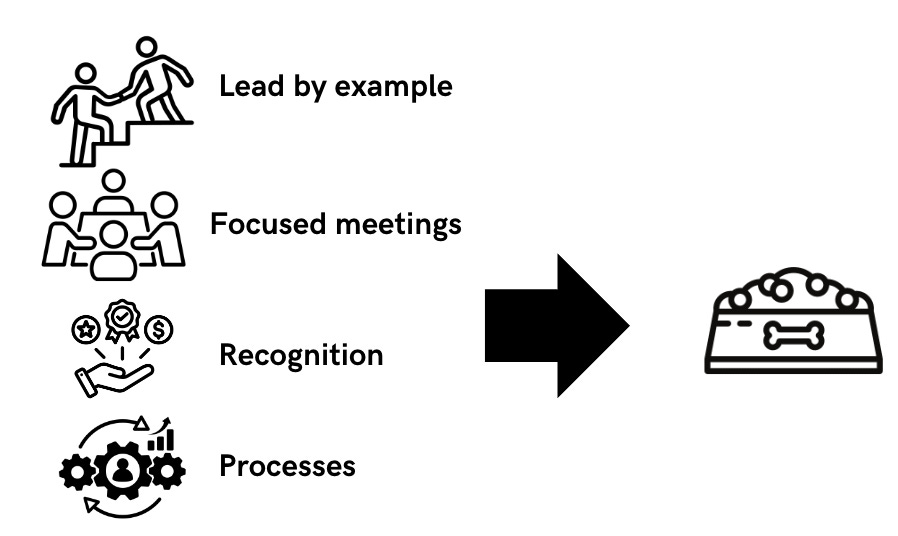The last three articles explored the parallels between macronutrients and team management elements: carbs were seen as motivation to inject energy into teams, protein as continuous improvement to build team strength, and fat as strategic thinking for long-term sustained team health.
In this article, we will begin shifting our focus to micronutrients. We will start with Vitamins, specifically Vitamin A. Vitamin A is a fat-soluble vitamin, which means it’s absorbed with fats. Aside from strengthening immunity against infections, Vitamin A is essential for maintaining healthy vision and helps convert light into signals our brains can interpret, enabling us to see clearly. In engineering teams, clear eyesight can be thought of as deeply understanding customer needs and the product the teams work on.
One effective method to achieve this is “dogfooding,” a practice where team members use and test their products to identify potential improvements, find bugs, and think about new solutions. This process ensures that teams remain closely connected to the user experience, mirroring the role of Vitamin A in enhancing and maintaining eyesight.
How to provide Vitamin A to your body
We clarified that Vitamin A is important for your health - how can you provide it to your body through food?
Vitamin A, in its preformed (ready-to-absorbed) version as retinol or Vitamin A1, can be found in foods such as beef, liver, and dairy products.
Your body can also generate retinol from carotenoids (such as alpha-carotene, beta-carotene, gamma-carotene, and beta-cryptoxanthin), which are plant-based precursors to Vitamin A. Foods with high concentrations of carotenoids are orange and yellow fruits and vegetables, such as butternut squash, pumpkins, sweet potatoes, carrots, and persimmons.
How to instill dogfooding in your teams
In a parallel way, how do you instill “dogfooding” in your teams? Engineering leaders should advocate for a culture of dogfooding, ensuring that teams regularly engage with the product just as consumers would.
Engineering leaders should lead by example and be the first to engage with the product, testing features and publicly reporting issues or improvements (via email or Slack).
If a team doesn’t do dogfooding right now, one way to kickstart this practice is to pick a theme or feature every week and arrange a meeting of an hour (or half an hour) for the team to get used to testing and using the product.
Engineering leaders could also recognize people who submit many issues to incentivize the behavior.
Leaders should also refine the process around “dogfooding”. For example, you might want to apply dogfooding to internal versions of your product that have yet to be released. For a mobile product, your company might need to support the creation of a separate internal app associated with your master/main build updated frequently. For a web product, you might use a staging or pre-prod URL where the changes are integrated.
This practice makes the team more user-centric and helps foster a deep sense of empathy and understanding for the consumers using their product. For example, I experienced a strong culture of “dogfooding” at a couple of companies (Snapchat and Pinterest), where employees using the internal app logged tens of bugs daily and weekly. This helped teams find bugs before releasing them to the public and built a culture of ownership and accountability.
Challenges with dogfooding
There are also challenges with “dogfooding”. Team members might not represent the typical users or the whole variety of users a company has, so it’s important to avoid biases. Product and engineering leaders must be aware of the diversity of users using their products and ensure that dogfooding is just one input. In the same way, vitamin A is not the only element needed for good eyesight.
In companies where this practice is widespread, another challenge can be the overload in triaging all the incoming tickets raised by internal employees and for example, in some cases, the high number of duplicated tickets. Similarly, too much Vitamin A (the current Upper Limit is 3,000 mg of retinol) can cause vertigo, nausea, or blurry sight. It is worth noting that this can happen only using supplements; it will be pretty impossible to get to a similar amount from just eating food, especially plant-based (E.g., 1 cup of baked sweet potatoes gives you 23mg of beta-carotene which gets converted into around 12mg of retinol).
In conclusion, an adequate level of Vitamin A in your diet is key to avoiding night blindness and issues with eyesight. In the same way, dogfooding is important to have a team that sees how the user experiences its product and builds a culture of ownership, empathy, and accountability.









